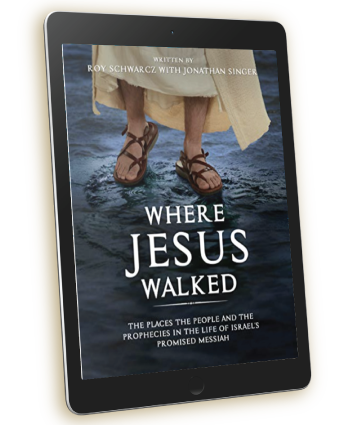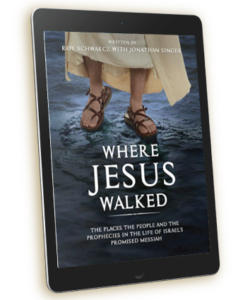Matthew 9:1-9 One of the foremost tenets of the New Covenant is that sin can be forgiven, and that man can be brought into fellowship with God. The King who has come to bring the kingdom now demonstrates that He has the power to forgive sin. Sin is the root of all of man’s physical, emotional, and spiritual troubles. It was sin that separated God from man, and man from man, and man from himself. The King came to establish his kingdom by restoring that which was lost.
Yeshua’s own city is now Capernaum on the Sea of Galilee. In verse 2 Jesus heals a man who was paralyzed. It was bad enough to be paralyzed but in the religious mind this paralysis, we are told he was the direct result of sin. The five who approached Jesus had great faith in Him. Yet we should not make the mistake that Jesus healed only where there was faith. In this verse we see that Jesus brings comfort to this man by telling him his sins were forgiven.
Forgiveness was the greatest gift of the King. Sin is transgression of God’s law; it is hostility and rebellion against God. It cannot be cured by man himself, Jeremiah 13:23. It results in man experiencing trouble, emptiness, lack of peace, and ultimately eternal hell if he does not repent. Job 5:7,Romans 8:20,Isaiah 57:21,2 Thessalonians 1:9.
The response was that this must be blasphemy rightly understanding that only God can forgive sin. This is why the deity of Jesus is such an essential doctrine. Isaiah 43:25.
Jesus was able to discern their thoughts. John 2:25,1 Samuel 16:7,1 Kings 8:39. But sadly they did not even think through their own theology. For someone to be able to heal all who came to Jesus there would of necessity be some forgiveness of sin. Why? because most disease and sickness is the result of sin. If healing occurred, then of necessity, in some cases, sin had to be forgiven, which only God could grant. So, in order that they would know that He could forgive sin, which they could not see, He did what they could see by healing. The result was that when the multitudes saw this, they were filled with awe. The Greek word is Phobeo, where we get the word phobia from. It is the kind of fear that fell on Israel when the Law was given at Mt. Sinai. Exodus 19. For a greater law had now come.
The only people who receive forgiveness and salvation are those who acknowledge their sin and their need for a Savior. Those who thought of themselves as righteous could not be saved. Matthew 9:13. The righteous do not need a Savior, but the fact is that there none are righteous. Romans 3:10-12, Ecclesiastes 7:20. After Jesus forgave the sin of the paralytic, the question in the mind of some was: “How much sin is God willing to forgive? Who qualifies for forgiveness? Are there conditions? This is what is dealt with in Matthew 9:9-17. By calling Matthew he was showing how limitless God’s forgiveness is.
Matthew 9:9-17 Matthew’s name means “Gift of Jehovah”, and he was a tax collector for the Romans. He was commissioned by Rome to collect a certain amount and anything more he could keep. He had the Roman army at his disposal to help him extort money from his own countrymen. He received bribes from wealthy Israelites so that they could pay less taxes and get the difference from the poor and middle classes. Is it any wonder that he was despised and considered one of the worst of all sinners. According to Jewish theology the only just government was one that was led by the God of Israel. That is why Jesus was asked if it was proper to pay tax to Rome. Matthew 22:17. Tax collectors were banned from the Synagogue and considered as unholy as pigs.
Matthew 9:9-17 – The King desires His subjects to understand that His Kingdom is completely different from that of the world and its religions. Religion is man reaching up to God. It extols those who are able to reach the highest and looks down upon those who have given up or never try to reach up. The King of Israel came to bring a relationship with God not religion. This relationship is contingent upon our willingness to acknowledge our sin and independence of our Creator, and our desire to seek His provision for us, His creation. We now have a contrast of these two systems given in this portion of Scripture.
Matthew was a man who traditional religion would have nothing to do with. Now we see Jesus eating with these unkosher people. Jesus now has the reputation of being a gluttonous man and an alcoholic Matthew 11:19,Luke 15:2. The Pharisees were furious with this action of Jesus because He told his disciples to live a life more holy than them. This group of Pharisees thought themselves without the need of God’s forgiveness and believed that this group Jesus was now associating with were incapable of God’s forgiveness.
This attitude was demonstrated also by the Sadducees who controlled the Temple and excluded the Gentile from their rightful place of worship. Jesus’s response to their challenge to his disciples is threefold.
1. The healthy do not need a physician, but those who are sick. The Pharisees could see the sickness but did not seem able to prescribe a cure that would heal the sick.
2. The God of Israel prefers compassion before sacrificial offerings. This is a quote from Hosea 6. The entire chapter of Hosea deals with Israel’s failure to obey God.
3. Jesus came to call sinners not the righteous. His parables dealing with the lost sheep, the lost coin, and the prodigal son all deal with this important concept of God and His Kingdom. God came to seek that which was lost and to restore that which was taken.
When asked by the disciples of John the Baptist why the ministry of Jesus was so different from the ministry of John, he gave illustrations to help them understand. Jesus describes himself as the bridegroom. The next two illustrations are given to attempt to explain that the teaching of the Messiah is a message not of this world or its system. It is a heavenly system, based on grace as opposed to works. Religion verses a living relationship with the Messiah.
Matthew 9:18-22 “While he was saying these things…” The companion verses in Mark 5:22,Luke 8:41 help us identify him as Jairus and that he was a Rosh Hakenesset, the highest ranking synagogue official. While the Temple was the center for sacrifice, the Synagogue was the local assembly of the Jewish people. The Temple was controlled by the Sadducees who did not believe in the resurrection, while the Synagogue was led by the Pharisees and Scribes who believed in the promises of the Messiah, the hope of the resurrection and the coming kingdom.
Jairus was fully aware of the censure that was sure to come his way for approaching Jesus. But his daughter was so sick and near death that he didn’t care. He fully believed that only Jesus could heal his daughter. From the Mark and Luke accounts we learn that when he started his journey to Jesus his daughter was still alive.
Jairus’ need and his faith caused Jesus to marvel. Up until this point Jesus healed people but the idea of raising the dead had not occurred. Martha and Mary believed that Jesus could heal the sick but when it came to raising the dead that was another matter John 11:22-23.
God was already working in the heart of Jairus before he came to him. Even as God began working in our hearts before we came to Him. Jairus was desperate, he had nowhere else to turn for help for his little daughter. He believed that Jesus could heal his daughter. Jesus responds to his need by rising and following him.
The woman who was healed had tried everything to be healed over a period of twelve years. This meant that she was continually unclean. The Mosaic law required that for her to be declared clean she had to go seven days without any bleeding. Upon being pronounced clean she could then offer her sacrifices and be accepted by the Lord. Until that occurred this woman was excluded from the Synagogue and the Temple, because she would contaminate anyone she met. Even her family associations were curtailed. The fringes that Jesus wore was in keeping with the commands of Numbers 15:38. She was so accustomed to being ostracized that she didn’t dare outwardly have any contact with him. Jesus was unconcerned because rather than be defiled He had the ability to make clean.
Matthew 9:23-26 – Jewish funerals involved several ways of expressing grief. First there is the Keriah; the tearing of the garment. Tradition calls upon the Jewish person to tear his garments, to put the mark of the broken heart on our clothing, and not to vent our feelings. In accordance with respect for the deceased the body should never be left alone from the moment of death until the burial.
The family traditionally has someone always stay at the side of the body. In the time of the Messiah professional mourners were employed who not only sat with the body but would loudly wail out the name of the one who had just died. Mourners are released from all positive commandments, ie. tefillin, until after the funeral. The body must be washed accompanied by prayers and Psalms. The burial is to take place within twenty-four hours.
This aids the bereaved in confronting the finality of death. Also, at the time of Jesus musicians were hired to perform. Because of Jairus’ wealth there were many professional mourners and musicians. When Jesus ordered them to depart, they must have been surprised and upset because what they were doing was proper and required.
When Jesus said that the girl was merely sleeping, an allusion to resurrection, they began to laugh. Some might see this as indicative of their emotional separation from the child since they could be brought to derisive laughter so quickly. He took her by the hand, Mark 5:40-41 tells us the words He said cf. Luke 8:55. The news of this spread quickly throughout the land. Now it was evident that Jesus not only had the power to heal disease, cast out demons, forgive sins, but also to raise the dead. This is the single most important credential of the Messiah of Israel.
When D.L. Moody was looking for words of wisdom from Jesus that he spoke at a funeral he discovered that Jesus never preached at one.
Matthew 9:27-31 The healing of the blind men was more in the continuing evidences that Jesus was the promised Messiah of Israel. The age of Messiah was a to be a time when “the eyes of the blind be opened and the ears of the deaf unstopped. ”Isaiah 35:5. Jesus healed more blindness than any other disease. This is indicative of the prevalence of much disease and sickness. The fact that they addressed Him as son of David, indicates that they believed that he was the promised Messiah (2 Samuel 7:12ff). Their faith was evident by their persistence but when Jesus asked them if they believed it was probably to get them to openly confess that Jesus was Lord (Romans 10:9). Faith was not always necessary for healing, but it is always necessary for salvation. The reason he commanded them to be silent was likely because He did not want His messiahship being proclaimed as king of this world. He continually avoided any acknowledgement of His kingship in this world, but rather the Kingdom of God.
Matthew 9:32-34 – This portion is similar but different than the casting out of a demon in Matthew 12. The similarity lies in that at the end of both events Jesus is accused of being able to cast out demons by the ruler of the demons. The difference is that this man is unable to hear or speak while, in Matthew 12 the man is both blind and dumb.
When the demon is cast out he is able to hear and speak. Notice the marvel at this healing. The reason for marvel is that in the Jewish exorcism there was a procedure. The exorcist would speak to the demon who would use the person’s possessed vocal cords to speak back to the exorcist. The exorcist then had to determine the name of the demon, once the exorcist knows the demons name he was then able to command that he leave the person possessed.
We see this procedure being used in Mark 5:9 by Jesus. In this case the demon could not speak and thus could not be identified and cast out using Rabbinic techniques. The Rabbi’s taught that when the Messiah comes that He would be able to cast out this kind of a demon. Rather than accepting this as a sign or credential of the Messiah, the Pharisees hardened their hearts and said that he was an emissary of Satan. This is the sin of against the Holy Spirit as stated in Matthew 12:31-32.
Matthew 9:35 The region of the Galilee was an area of 280 square miles. According to Josephus the area contained at least three million people. Jesus taught in the Synagogue, which was not only a place of worship, but a place for judgment, and records of land and local genealogy.
There was a tall pole that went high into the air to help identify them much like today’s steeples. Because of the policy called “freedom of the Synagogue”, any qualified man could explain the daily portion of Scripture. Jesus and later Paul took advantage of this freedom to proclaim the Gospel. The Gospel of the kingdom was the message of the New Covenant. His healing of diseases fulfills the words of Isaiah 53:4.
Matthew 9:36-38 The Good Shepherd had compassion unlike the false shepherds. This was prophesied in Ezekiel 34. Jesus had compassion unlike the religious leaders. Matthew 23:4. Jesus called false teachers thieves, robbers and strangers from whom people should free. John 10:1,5. On the other hand the burden of our Teacher is easy and His yoke is light. Matthew 11:28-30.
It is at this point that Jesus begins to reveal that His work is to be accomplished through the Disciples. God’s plan is articulated in 2 Timothy 2:2. We are called to be like the Good Shepherd as under shepherds. Not just those who are in full time ministry but all of all of us. Ephesians 4:11-12. We are told to pray that the Lord of the Harvest will send out workers into His harvest. Prayer is foundational to all our activity.


